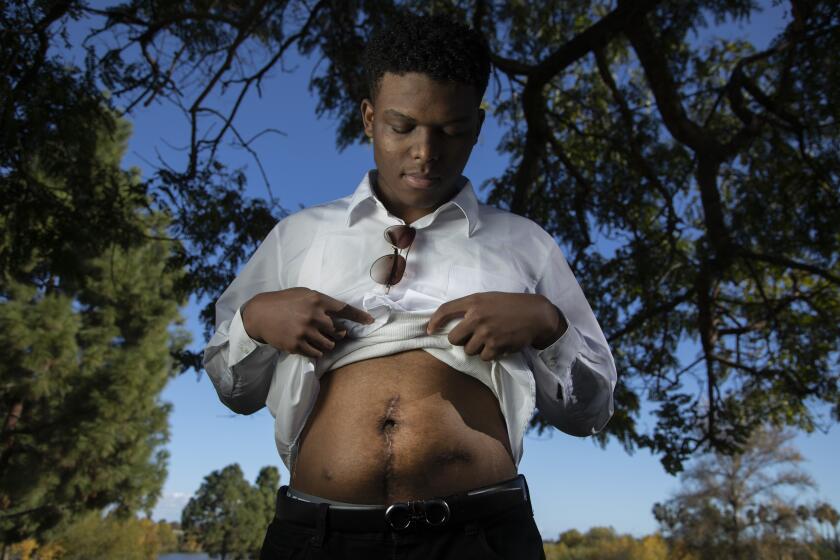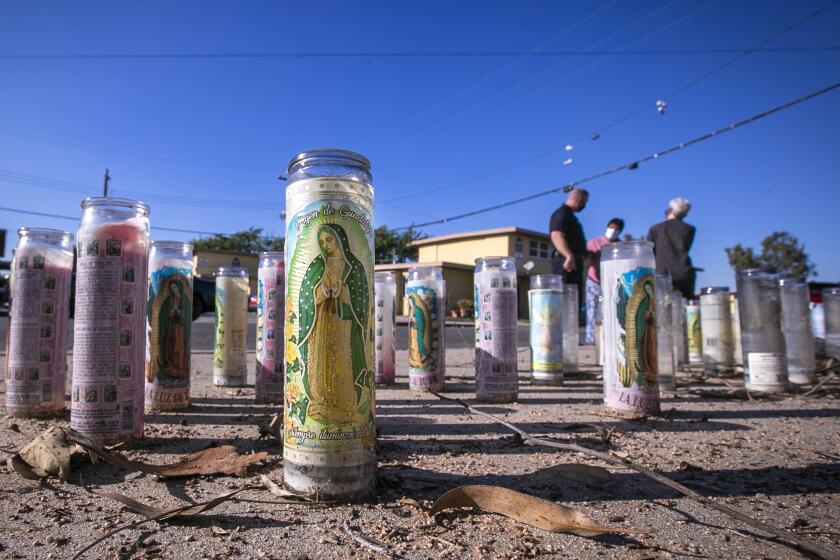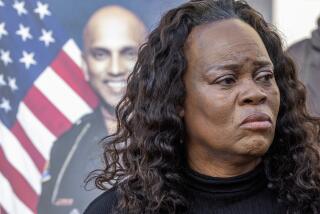For one Pasadena neighborhood, gun violence is unrelenting
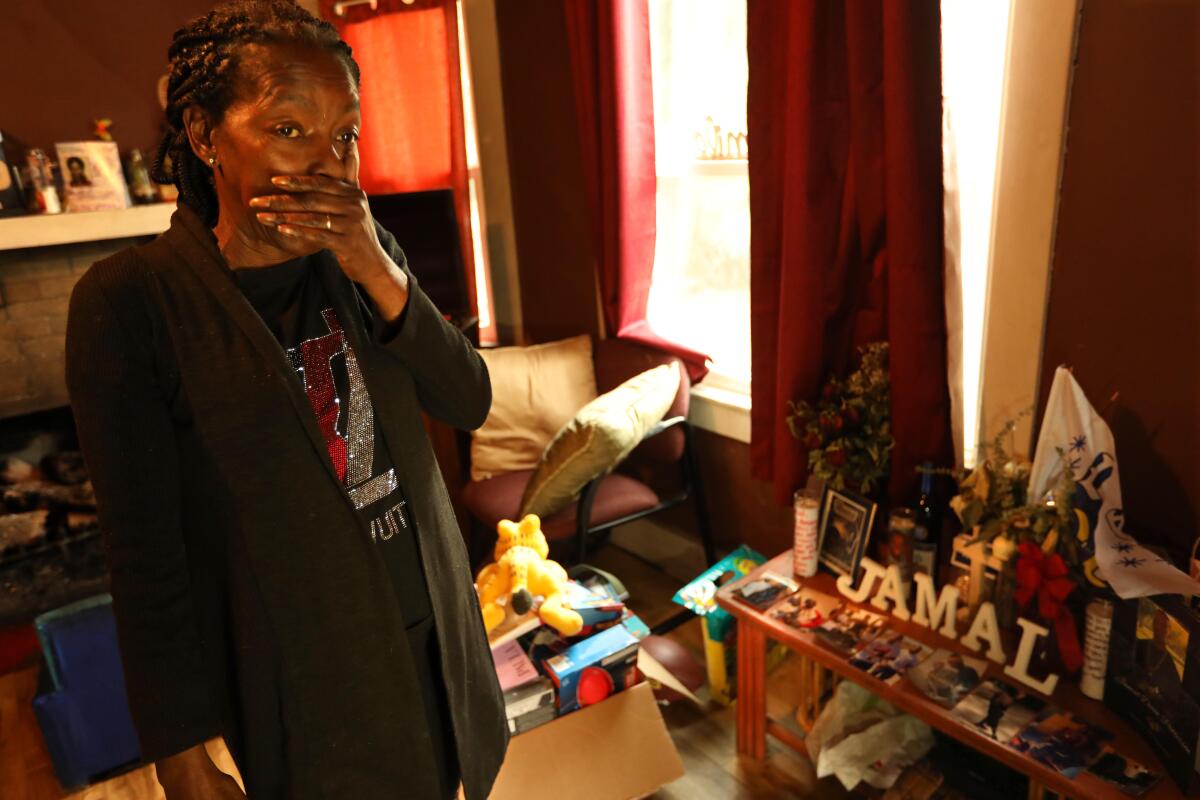
- Share via
The streets were slick with rain in northwest Pasadena when Jamal Patterson went to watch “Monday Night Football” at his mother’s house last October.
The 24-year-old was sitting in a car with two other men across the street from his mother’s home after the game when someone shot into the car. Patterson usually sat on his mother’s front porch with his friends, but the recent rain made everything wet.
Patterson, a father of two, died three days later at Huntington Memorial Hospital.
One month later and one block over on Raymond Avenue, 13-year-old Iran Moreno was playing video games in his home when he was shot by someone who fired from the street. He was rushed to the same hospital as Patterson and died later that night.
“There’s always shooting, always gang violence around. They’re always hurting the most innocent people,” Iran’s cousin, Maria Balvaneda, said during a vigil at Villa Parke.
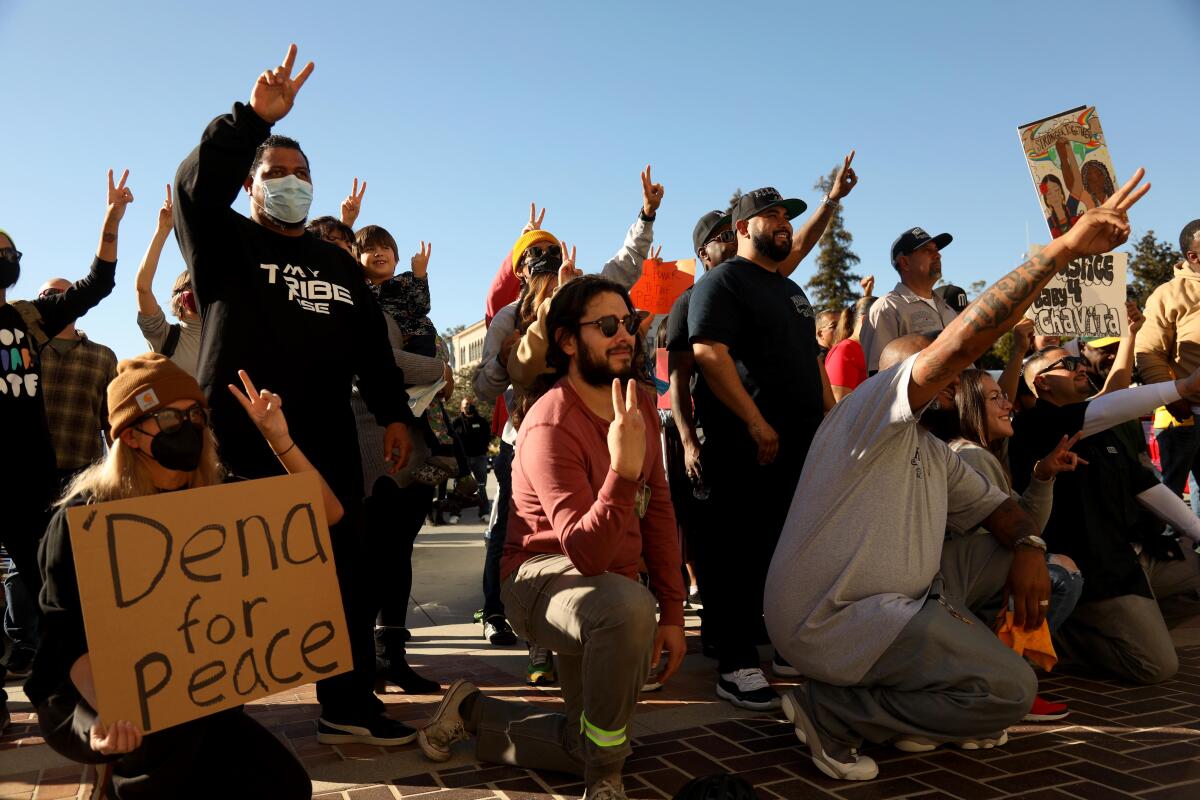
In Pasadena, shootings rose 22% between 2020 and 2021, from 60 to 73, according to the police department. Seven were killed in 2020 and six more last year.
The increase — part of a spike in homicides across Los Angeles County — has sparked grief, pain and outrage in a city marked by many upscale neighborhoods, as well as lower-income neighborhoods where crime has long been a problem, and some residents say city leaders are not doing enough to make conditions safer.
The shootings in Pasadena have been concentrated in the northwest part of the city, home to mostly Black and Latino residents. In response, city leaders and police have increased patrols in the neighborhoods hardest hit by the gun violence and have pledged to bolster after-school programs and invest in ShotSpotter technology.
Nearly 400 people have been killed in L.A. in 2021, marking a 50% increase since 2019 and the loss of 15 years of progress driving down such violence.
ShotSpotter, a gunshot detection service, alerts police when someone fires a gun near a sensor, and cities across the country have embraced the technology as a way to cut down on the time between when a shooting is reported and when police arrive on the scene.
The technology, however, feels like a half measure to some Black and Latino residents, who have seen more shootings despite the increase in police patrols around their neighborhoods.
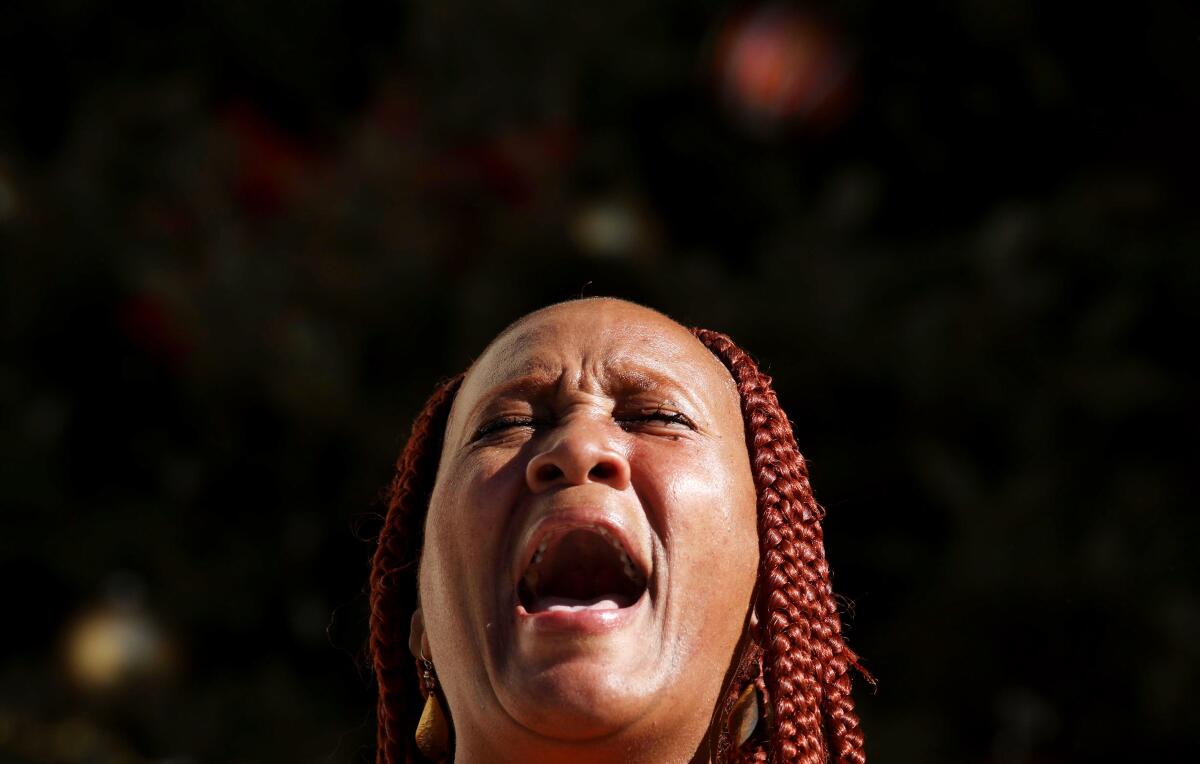
“That technology is meant to help police after a shooting takes place and only time will tell how efficient that is in Pasadena,” Florence Annang, a community organizer with the nonprofit Pasadenans Organizing for Progress, said. “But what good is that to the safety of the people who live in the neighborhoods that constantly have to duck when they hear gunshots? It’s too late for them because the bullets have already left the gun.”
Annang and other residents in northwest Pasadena predict a larger police presence will lead to racial profiling as Black and Latino men are singled out for possibly being affiliated with a gang just because of where they live.
Even as crime and homelessness mount, many longtime residents are worried about gentrification, as flippers quickly renovate homes and slap on million-dollar price tags.
Mayor Victor Gordo supports ShotSpotter, which the City Council approved last year. He also supports an increase in gang intervention measures that engage children over the long term, along with more police patrols.
“I don’t think we should be coy about it. These are people who are unlawfully running around and shooting at each other,” Gordo said. “I’m not going to sit around and apologize, because I’ve asked for more patrols to get these people off of our street and into jail.”
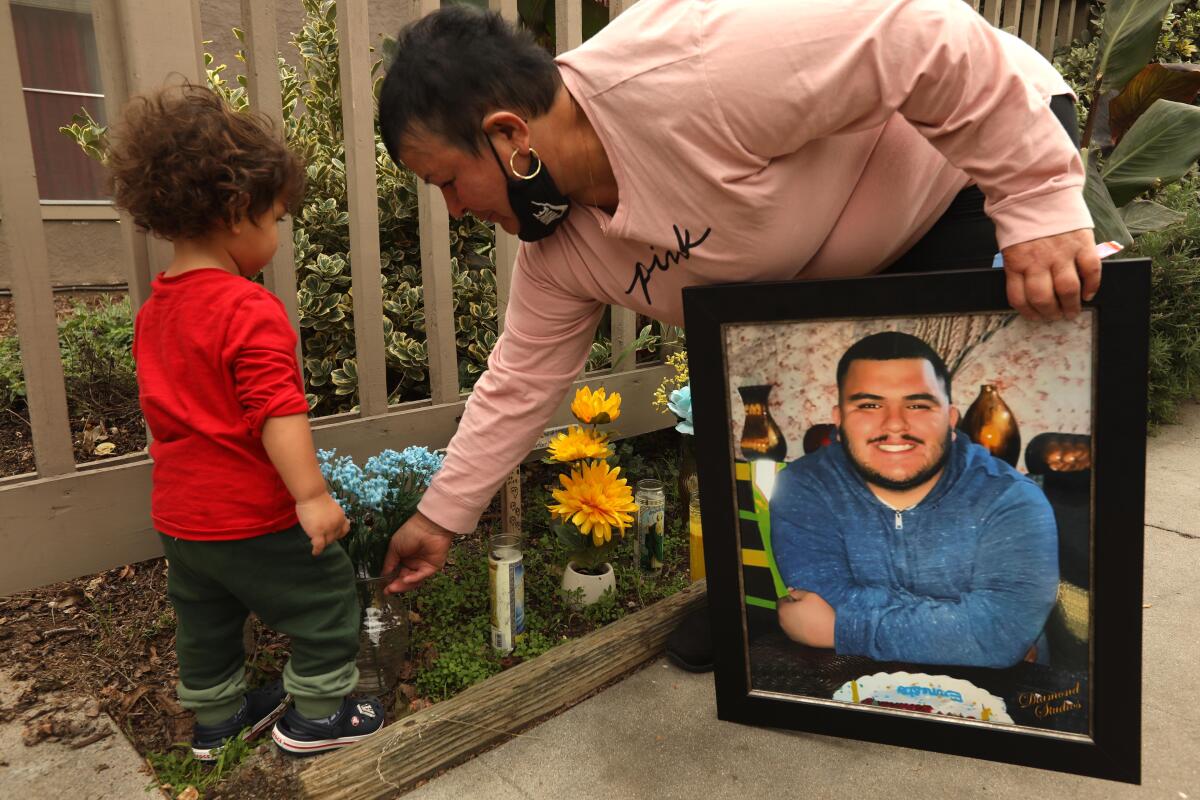
Calls for justice from elected officials ring hollow to Maria Jimenez, whose son Ernesto Jimenez was shot and killed down the block from their home more than a year ago. No arrests have been made in his killing and her anguish has numbed her to most of the world, says her daughter, Yesica Valdivia.
It was the second time 27-year-old Ernesto, a mentally disabled man who often helped carry his neighbors’ groceries, was shot in a drive-by shooting in northwest Pasadena. The first time was in 2015 when he was hit twice in the street.
On Nov. 13, 2020, Ernesto was shot 21 times as he walked to Villa Parke, where he often visited with his houseless neighbors and brought them food.
Christino Medellin Avila, 51, and Aaron Perez Flores, 40, who both worked as day laborers, called Ernesto their deejay because he often carried a Bluetooth speaker on his hip, Valdivia said. Ernesto’s playlist included Spanish pop from Juan Gabriel, cumbias and oldies in English. But Valdivia said his favorite song was “I Want to Break Free” by Queen, because he wanted to escape from his disability.
On Dec. 1, 2020, the day after Jimenez buried her son, Avila and Flores were shot and killed at Villa Parke while they sat on a park bench, less than a block from where Ernesto died.
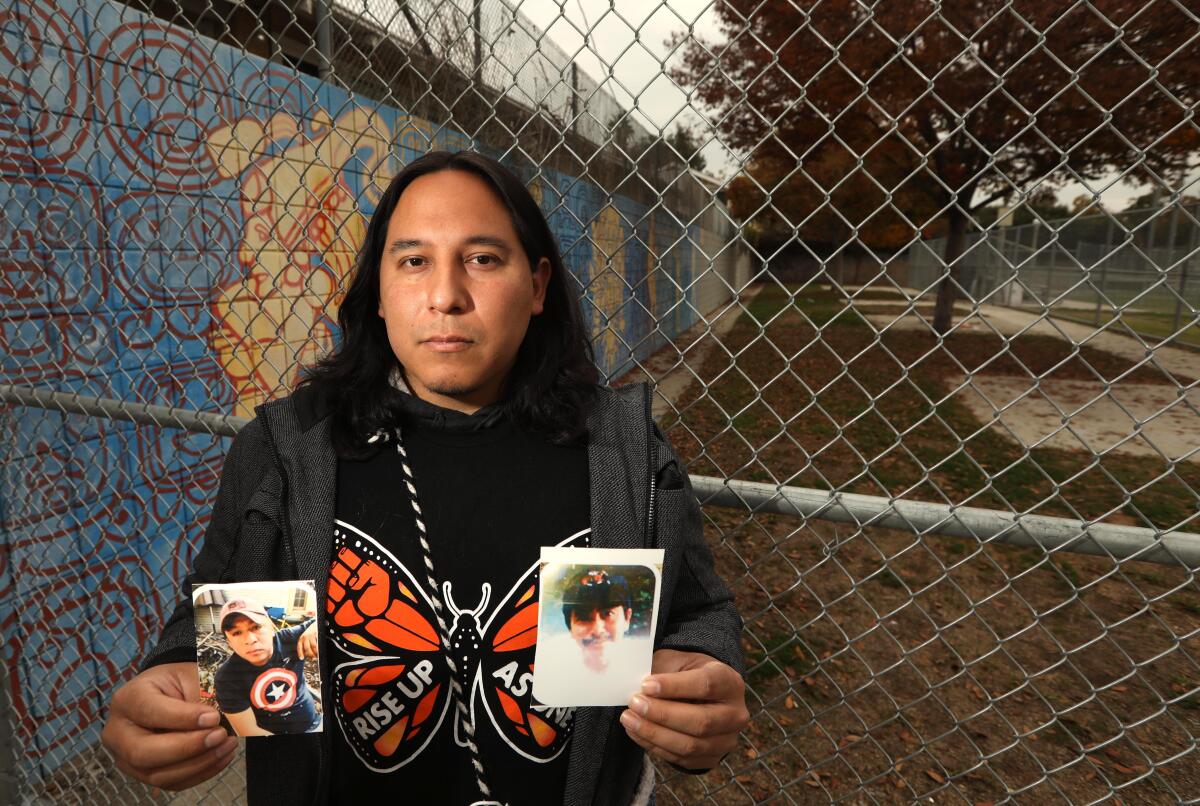
Avila’s nephew, Jose Madera, grew up in northwest Pasadena and said his uncle’s death a year ago was a shock to everyone in the family, because he was not involved in any gangs and regularly visited Villa Parke to socialize.
After his uncle’s death, Madera, 33, said he kept bumping into Avila‘s friends at the park. He said strangers would walk up to him to reminisce about his uncle, who was born in Puebla, Mexico.
Madera works as a program manager with Adelante Youth Alliance, a Pasadena-based nonprofit. “A lot of community members wanted to go back into the park after the shooting to connect with people,” he said. “We took it upon ourselves to go around and ask people in the neighborhood how they’re doing. How do they feel in their neighborhood park?”
The consensus was people wanted more police patrols, but also after-school programs, he said.
On a recent visit to the benches where Avila was shot, Madera found that the area had been closed off by a chain-link fence.
Watts had at least 22 homicides in 2021, a more than fivefold increase from 2018. But “Watts is not equal to crime,” one resident says.
Robin Bevan, who lives near the park, told Madera that she had called police and the city to complain about people drinking at the park a few weeks before Avila and Flores were shot.
“It was not a nice scene of all the people vomiting in the street while they were drinking,” Bevan said, telling Madera she meant no offense to him or his family.
Bevan welcomes the increased police patrols, but not the fence.
Former Pasadena Police Chief John Perez, who retired at the start of the year after 36 years with the department, says northwest Pasadena has struggled with gang violence and a lack of after-school programs. In the absence of those programs, police rely on enforcement of the law, Perez said. That means stopping people in neighborhoods with high rates of crime even when an officer doesn’t know if a crime has been committed.
“Our poor officers have to decide to stop young Latinos and Blacks they think may be involved in an activity,” Perez said. “Now I say they may think, because they don’t know. Again, back to the original point of not knowing if a crime is occurring, is the most difficult thing in police work.”
As the city continues to look for ways to curb the violence, residents say it’s also critical that the city lend support to families of crime victims.
Valdivia said her mother is now nearly incapacitated on most days since she lost her son Ernesto. She said her mother was told by a police officer that someone would contact her to connect her with a Spanish-speaking counselor, but that more than a year later that call hasn’t arrived.
“It just feels like my mother has been forgotten,” Valdivia said.
“Until my existence is done, I’m going to keep fighting for my son’s death,” Jimenez, 56, said. “I don’t feel safe here, but this is where my son’s memories are. I think if I go anywhere, if I move to a different place, I think I’m going to suffer more, because this is where my son walked.”
Lisa Lewis, whose son Jamal Patterson was shot in October outside her home, said Mayor Gordo visited her after her son was killed and offered the city’s support to raise funds for Patterson’s widow and two sons and to help the family with funeral costs. Gordo recently said that was a misunderstanding and he only referred Lewis to a victim’s relief fund. He told The Times, “We have and will continue to communicate with victims of crime.”
To Lewis, whatever misunderstanding she might have heard feels personal. That feeling of being overlooked or patronized after losing a loved one can add to the cacophony.
Annang and other activists have demanded the city hire a liaison to work with family members of the victims of violent crimes, to guide them through the process of filing paperwork and put them in touch with grief counselors.
A week before Christmas, several local lowrider clubs rallied outside Pasadena City Hall to collect toys for Patterson’s children and Iran’s siblings. Organizers called the rally a unity event between Black and Latino residents.
“If we don’t speak up, nothing happens,” Michelle Acosta Evangelista, a Pasadena resident and a mother, said as she joined the rally. “I’m hoping that today gives some light to our community. It doesn’t matter the color of our skin. It doesn’t matter what age. This is where we live. This is our home.”
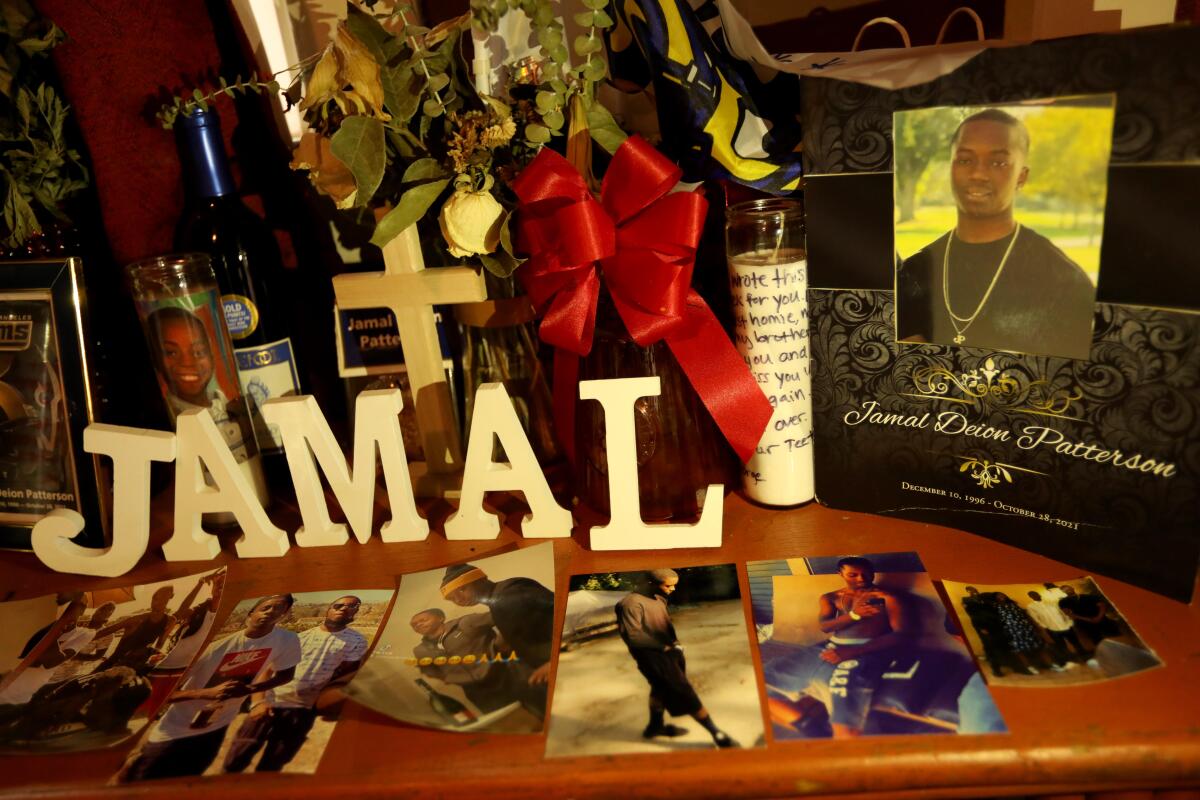
Inside her home, Lewis has a memorial to Patterson and his favorite football team, the L.A. Rams. There’s also a painting of her son as an elementary school student on a candle. His beaming smile shines.
The night her son was shot, Lewis found him at Huntington Memorial Hospital on life support.
Lewis said she leaned over and whispered in his ear, “Every time I feel the breeze on my cheek, I’ll know it’s you giving me a kiss.”
A little over a month later, Lewis said she heard a booming voice outside her home. SWAT officers were on a bullhorn calling to an apartment across the street.
Police arrested and charged a 16-year-old boy with Patterson’s slaying. Police also arrested and charged 24-year-old Cecilio Hernandez with Patterson’s killing, and 40-year-old Angel Martinez was charged with possession of a firearm by a felon.
On a chilly December afternoon, Lewis stood in her frontyard and pointed across the street to where her son died.
“Every day I have to open my door and walk out to where Jamal was killed,” Lewis said.
Times staff writers Brittny Mejia and Maloy Moore contributed to this report.
More to Read
Sign up for Essential California
The most important California stories and recommendations in your inbox every morning.
You may occasionally receive promotional content from the Los Angeles Times.
